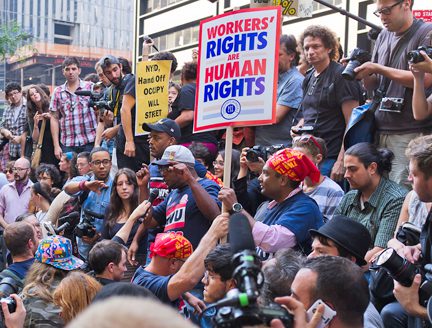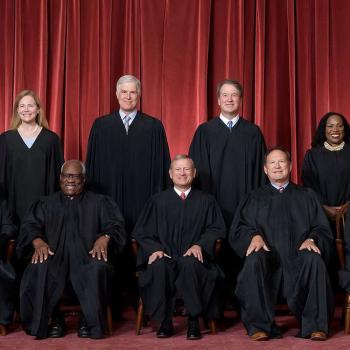The white working class is often assumed to be a hotbed of racism. And yet it’s primarily the working class where the different races work together, play together, mingle socially, intermarry, and have children together.
So observes Juli Burchill, referring specifically to racial relations in the UK, in her article The British working class is what real anti-racism looks like. Conversely, as the deck to the article says, “It is the elites who are obsessed with race and division.”
She cites a report that found that in the UK not only racial minorities but members of the white working class are subject to police violence. Here are some quotations from Burchill’s article that sum up her argument:
Culturally, black Britons have much more in common with their white neighbours than is ever acknowledged. It’s hard to swallow the bourgeois belief that the further one goes down the social scale, the more racist people are. How to explain, then, that at the end of every single reality or talent show, multihued families embrace; usually, a young man of colour will be surrounded by a crying, congratulatory mob of little white ladies, generally his mother and aunties.
It’s been nearly 20 years since Michael Collins’ brilliant book about the demonisation of the white working class, The Likes Of Us, was published. He wrote:
‘The modern-day white working class had a more varied, more honest, more intimate experience, having known non-whites as lovers, muggers, husbands, killers, wives, victims, neighbours, rapists, friends, foes, attackers, carers. For decades, the urban, white working class had largely been educated in multiracial schools, worked in multiracial environments and lived in multiracial neighbourhoods.’
This remains truer than ever. Growing up in the English cities of the 1970s, most of us had black friends. Everyone loved the West Indian kids at school. Literally, as it transpired. . . .[The rise in interracial marriages] happened because of the proletariat – the young women of which can often be seen pushing beautiful biracial babies in prams.
It is the privileged left-wing media types, having not been around their black compatriots in the normal way from their youth, who commit the worst racial gaffes. . . . You would almost think that the ruling class – despite its exhaustive virtue-signalling where race is concerned – doesn’t actually see black citizens for who they are as individuals. Rather, they are units to be corralled.
Does this apply also in the U.S.? Certainly, the racial picture in the UK is different than it is here. America has the legacy of slavery. The UK has the legacy of colonialism. A side effect of the globe-spanning British Empire, which morphed into the more independent Commonwealth of Nations, was immigration rights.
As a result, Great Britain has a large number of not just immigrants but citizens originating in Africa, the Caribbean, Hong Kong, Malaysia, Pakistan, India, and other former outposts of the British Empire. The UK, like Europe in general, also has a significant number of more recent immigrants from Muslim countries.
What these populations have in common is that they wanted to come to England. The Asians often came with significant wealth and merged directly into the middle or even upper classes of Great Britain’s relatively stratified society.
As for the United States, we have always been a nation of immigrants and still are. That we don’t control our borders is a major problem, but legal immigrants still come here from all over the world. Our distinctly racial divisions have mainly to do with the descendants of African slaves who were brought here against their will, freed with the Civil War, and subjugated by Jim Crow laws. Their legal rights were restored, though, with the Civil Rights movement, but discrimination sometimes continues.
Back during the Civil Rights movement of the 1960s, which I am old enough to remember, it did seem that poor whites–the “rednecks” of popular culture–were in the vanguard of the opposition, displaying their racism proudly. And yet, the poor whites of the South never owned slaves. They didn’t have enough money, let alone property or businesses that demanded labor. I heard it said that the ruling class encouraged racism among poor whites so that they would think there was someone lower than they were on the social pecking order. Black people, it was said, had a place in Southern society, first as slaves and then as subservient workers. But poor whites had an even lower status, as expressed by the horrible epithet “poor white trash.” If the mistreated blacks and the mistreated whites would unite around their common interests, it was said, they could make changes, but racism was a means of preserving the status quo in favor of the ruling wealthy elite.
And yet, at least some of what Burchill says of British race relations rings true for the United States today. Members of the white working class–not to be confused with “rednecks” or “poor white trash”–are typically the product of integrated public schools, were on the same sports teams as their black schoolmates, work side-by-side with black co-workers, and often socialize together.
Yes, much of the white working class listens to country music, but so do lots of black people. Much of the black working class listens to rap music, but 70% of rap sales are to whites, many of whom are from the working class. And now, we are seeing a fusion of country music with rap.
As for interracial marriages, the evidence is mixed. Intermarriage rates are somewhat higher as education goes up, though studies also show that people in mixed-race marriages tend to live in “poorer” neighborhoods.
The point is, the working class (defined as those without a college degree, with lower incomes, who work in the industrial or service sector) is racially diverse. Whatever their race, members of the working class interact with each other, have much in common, and, more often than not, get along with each other.
“But racism is systemic!” the affluent college-educated elite progressive will respond. “Racism is not just about individuals of different races getting along with each other! Racism is built into our educational, legal, economic, and cultural systems!”
Well, if so, who is responsible for and in control of all of these systems? Not the working class. . . .More like the affluent college-educated elites.
Photo by Mat McDermott via Cambridge University Press, Creative Commons 3.0













